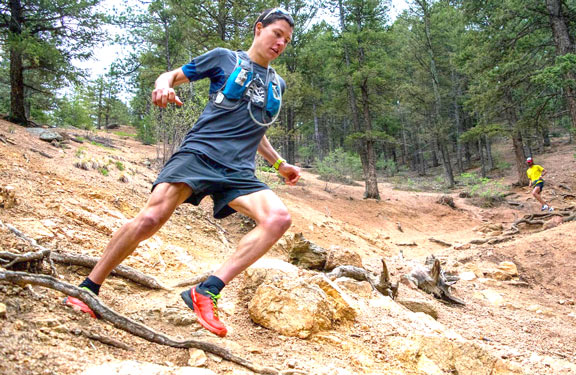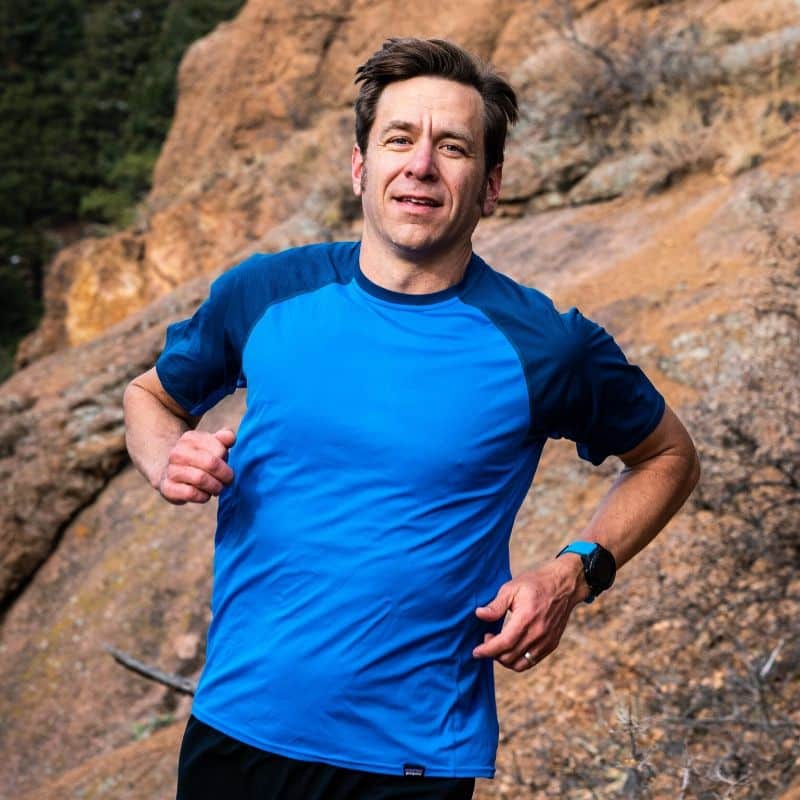
Maximizing Hot Weather Training for Ultrarunning
By Jason Koop, author of “Training Essentials for Ultrarunning”
Ultramarathon runners have to be prepared to compete in a wide range of weather conditions, from mid-day heat to late night cold, rain and even snow. It is important to recognize the difference, however, between preparing for the experiential challenges associated with weather and maximizing the effectiveness of purposeful training in specific weather conditions. Now that we are in June, many athletes training for summer events have to deal with training in the heat. Acclimating to exercising in the heat is a good thing, but to maximize your training you also need to minimize the impact high heat has on your workload.
Heat Acclimation vs. Training in Hot Weather
Heat is the enemy of endurance performance. Whether athletes are preparing for Western States 100 or the Badwater 135, the best you can hope for is to minimize the negative impact race-day heat will have on running performance. Heat acclimation (active process) or acclimatization (passive process) won’t improve your performance in hot weather; it reduces how negatively your performance will be affected.
The purpose of training is to apply stress so your body can adapt and grow stronger. When environmental conditions reduce the amount of work you can do, your training suffers. As core and skin temperatures increase you experience an internal battle for limited resources. Blood is shunted to the skin to assist in cooling, leaving less for oxygen delivery to working muscles. Blood flow to the gut is typically the first casualty, leading to reduced gut motility. Thermal discomfort also has a real and negative effect on performance, even if you think you’re great at powering through it. This is why it is essential to separate your goals of acclimating to running in a hot environment and training for maximum performance response.
There are a number of strategies you can use to continue training effectively during periods of hot weather.
Schedule adjustments
The obvious way to work around the detrimental effect of heat on purposeful run workouts (interval training) is to train during cooler periods of the day. Many runners shift to morning or evening runs instead of performing interval workouts in the mid-day heat. Athletes who cannot make that schedule change may consider performing mid-day interval workouts indoors on a treadmill in an air-conditioned space.
This is typically when athletes push back and say something like, “If I have to race in the heat, then I need to train hard in the heat, too!” Remember, the efficacy of interval workouts is based on the quality of your efforts. Develop fitness in the best environment to do so; exercise in a hot environment to minimize how much of that fitness the heat strips away.
To balance the needs of purposeful training and heat acclimation I recommend performing your endurance runs in hot environments. These training sessions will not be as detrimentally affected by heat because the intensity is lower, and the exposure to heat will aid in acclimatization. For most athletes who live in regions that experience hot summer days and are preparing for events with similarly hot daytime temperatures, additional heat training protocols may not be necessary. If you are preparing for extreme heat (Badwater 135) or live in Alaska, you might benefit from engaging in proactive heat training strategies.
Hydration Monitoring
The WUT protocol (Cheuvront and Sawka, 2005) is an easy way to assess your day-to-day hydration status. When you wake up, assess your level of thirst. Then observe the color of your urine. After you have urinated, weigh yourself without clothing.
Your morning urine should be light in color or relatively clear. The tipping point for the WUT assessment is if your urine is approximately the color of apple juice or darker. Be aware, however, that clear urine does not necessarily mean you’re in the clear (bad pun intended). If you guzzled a full bottle of water before bed, your morning urine may be light in color because you consumed so much water in a short period of time. Ideally you also need to evaluate the color of your urine stream, not the diluted urine in the toilet.
Your weight should remain relatively constant from day to day, varying about 1%. Even if you are gradually losing weight as part of a weight management goal, the changes from one day to the next won’t vary more than 1%.
When only one of three indices is abnormal your hydration status is likely good. When two of the three indices are abnormal, you are likely dehydrated. And when all three indices are abnormal you are very likely dehydrated. Starting your day with a better hydration status means you are optimally prepared for a better and more productive training session or competition.
Hydrate Before Exercise
When your day-to-day hydration status is good, you have a better chance of having a great workout or event performance. The next step is to consume 16-20 ounces (a regular sized cycling water bottle is typically about 20 ounces) of cold fluid (water or electrolyte-rich sports drink) in the hour prior to exercising in the heat.
► Free Ultrarunning Training Assessment Quiz
Take our free 2-minute quiz to discover how effective your training is and get recommendations for how you can improve.
This pre-workout bottle serves three purposes:
- Fluid intake. This is the obvious one.
- Spares the fluid you’re carrying. Although it’s a good idea to consume fluids early in workouts, in the real world a lot of athletes wait at least 20 minutes before drinking. Runners carrying bottles automatically start rationing fluid to make it last longer. Consuming a bottle before you leave gets water on board, so to speak, for this early period of your workout.
- Pre-cooling. We’ll cover this in more detail later in this article.
What about hyper-hydration or pre-load hydration products?
Hydration products marketed as hyper-hydrators are designed to increase the amount of water your body stores, and they do so by supplying a huge amount of sodium. The idea is that by starting hot-weather exercise with greater body water, you have a bigger reservoir to absorb heat from working muscles, move it to the skin, and dissipate it as sweat. As a result your core temperature doesn’t start rising as early, and rises more slowly during the first hour of exercise. However, these products are not recommended for everyday use. They contain extremely large amounts of sodium (3.5 grams/liter, or 1700mg/500ml bottle). You don’t need these drinks for short or moderate-intensity workouts. They are purpose-specific drinks designed to for athletes training or competing in extreme conditions or athletes who consistently struggle with significant weight loss (5+%) during exercise, are always craving salt, and finish workouts crusty with salt on their skin and clothing. If you consume them when you don’t need them, the high sodium content can lead to nausea. When might you use one? Perhaps before a long and/or very intense workout or race in abnormally hot weather. As always, try it in training before utilizing it in competition.
Use Pre-Cooling Strategies
While it would be great if you could schedule interval training in cooler environments, that’s not always practical. If you’re going to be working hard in a hot environment, you can consider some pre-cooling strategies. Starting with lower core and skin temperatures increases your heat storage capacity (you store heat internally even when you sweat), meaning you can accumulate more heat in your body before reaching a temperature that hinders performance. Pre-cooling will not prevent you from reaching high skin or core temperatures during a long or strenuous workout, but it will give you more time to perform high-quality work before core temperature hurts your performance.
Enjoying This Article? Get More Free Running Training Tips
Get our coaches' best training advice, delivered straight to your inbox weekly.
Lots of pre-cooling methods have been studied, and most are effective but impractical. You can immerse your body in cold water or take a prolonged cold shower, but those are inconvenient. Cold air exposure (much colder than normal air conditioning) can be effective, but it requires a long time to work.
From a practical standpoint, here’s what works:
- Cover your torso with cold, wet towels. The key is to cool a relatively large portion of the body, which is why ice vests or wet towels will do more good that cooling just your hands, arms, or neck.
- Ice sock around your neck. If wrapping in cold towels is not an option, consider a sock filled with ice. Because this will result in a soaked shirt, this is often used outside during a warmup rather than indoors before leaving for your run. As such it is both pre-cooling and during-workout cooling (for a little while, at least).
- Drink an ice slurry drink (Slurpee time!). Before exercise an ice slurry drink is a great choice. During exercise, research suggests cold water is better than an ice slurry because the ice slurry can signal temperature sensors in the stomach to reduce sweat response and skin blood flow, potentially causing you to store more heat (not what you want).
Getting the Best Bang for your Buck
It’s impractical for most athletes to do everything mentioned above before going out to train in hot weather. It’s best to keep it simple by choosing a few modalities you can achieve easily and consistently. For athletes who have jobs, families, and limited training time, the best bang for your buck will likely come from:
- Increasing daily fluid intake
- Consuming cold water or an ice slurry beverage before exercise in the heat.
- Scheduling interval workouts in cooler portions of the day (mornings)
- Scheduling moderate intensity endurance workouts in the heat of the day.
- Scheduling recovery activities in cooler portions of the day
Cheuvront, Samuel N., and Michael N. Sawka. 2005. “SSE# 97: Hydration Assessment of Athletes.” Sports Science Exchange 18 (2): 1–12.


Comments 6
Pingback: Heat Illness and Endurance Athletes: The Science of Staying Safe When It Gets Hot - CTS
Pingback: Maximizing Hot Weather Training for Ultrarunning – flyinghorsedesign
Thanks for the details on optimizing training in the heat. I followed Dr. Robert Kenefick’s work on solar load and wore a full brimmed hat and long sleeved shirt for a 4 hour race starting at noon in the mid 80’s. I was warm but comfortable and my competitors in running hats and bare arms suffered.
Pingback: Ultramarathon Daily News | Tue, June 6 | Ultrarunnerpodcast
Wonderful article – I struggle with running in the heat after winters in PA, and with two ultras on the schedule this summer, I will definitely use these training tips! Thank you!!
Very good suggestions. I tend to drink water and coffee when I awake in the mornings as drinking too much fluids just before going to bed usually makes me wakeup too many times during the night and thus I don’t get adequate sleep.